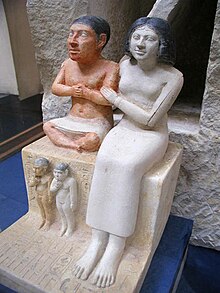Seneb

Seneb (left) with his wife Senites (right) and their children (below)
|
|
| Material | Painted limestone |
|---|---|
| Size | H. 22 cm (8.7 in); W. 22.5 cm (8.9 in); L. 25 cm (9.8 in) |
| Writing | Egyptian hieroglyphs |
| Created | c. 2520 BC |
| Discovered | Tomb of Seneb (G 1036), West Field of the Giza Necropolis |
| Present location | Egyptian Museum, Cairo |
| Identification | JE 51280 |
Seneb was a dwarf who served as a high-ranking court official in the Old Kingdom of Ancient Egypt, circa 2520 BC. Seneb was a person of considerable importance and wealth who owned thousands of cattle, held twenty palaces and religious titles and was married to a high-ranking priestess of average size with whom he had three children. His successful career and the lavishness of his burial arrangements are indicative of the acceptance given to dwarfs in ancient Egyptian society, whose texts advocated the acceptance and integration of those with physical disabilities.
Seneb is depicted with his wife and children in a painted sculpture from his tomb, rediscovered in 1926, that is a famous example of Old Kingdom art. It shows him sitting cross-legged on a block of stone with his wife embracing him and his children standing below him where the legs of a full-size person would ordinarily have been. The composition of the scene thus achieves a harmonious symmetry. It depicts Seneb realistically with the facial features and shortened limbs of an individual with achondroplasia, a common form of dwarfism. Paintings and carvings in the tomb give his titles and depict various scenes from his life, such as carrying out inspections of his estate and holding symbols of his office.
Seneb was buried in a mastaba - a flat-roofed brick tomb – located in the West Field of the Giza Necropolis near modern Cairo, where a large complex of ancient Egyptian royal tombs and mortuary structures was built, including the Great Pyramid. It was rediscovered by the German archaeologist Hermann Junker in 1926. The tomb is situated close to that of another dwarf, Perniankhu, a high-ranking royal courtier who may have been Seneb's father. Its date was long uncertain but is now firmly attributed to the reign of Djedefre (2528–2520 BC). His wife's name also appears in the nearby tomb of an official, Ankh-ib, suggesting that the families of Seneb, Perniankhu and Ankh-ib may have been related. Seneb was apparently buried with his wife, but no trace remains of the bodies, and the tomb was looted long ago, like most of the others at Giza. It was one of the first known attempts at building a ceiling dome over a square chamber, with the dome resting on jutting bricks at the corners of the room.
...
Wikipedia
